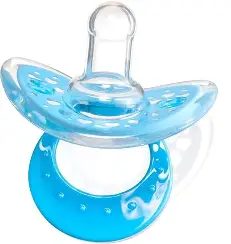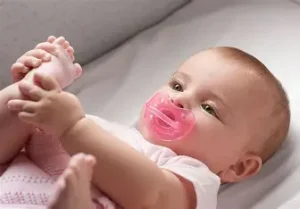http://shop nowLet’s face it—http://facebook.com baby pacifiers are magical little lifesavers when it comes to calming crying babies and giving you a few peaceful moments. But as your baby grows, there comes a time when that cute little binky needs to go. Wondering when and how to let it go without a fuss? You’re in the right place!
🚼 Signs It’s Time to Wean

Every baby is different, but there are common signs that your little one is ready to say goodbye to their beloved baby pacifier. One big clue is age—most experts suggest beginning the weaning process between 6 months and 2 years. Why? Because prolonged use can sometimes affect dental development or speech patterns.
Another sign is when your baby starts using the pacifier more for habit than comfort. If you notice they’re not sleepy, upset, or teething but still sucking away—yep, it might be time. You may also notice some crankiness when it’s missing, even during playtime. That kind of attachment could mean the pacifier has turned into a full-blown emotional crutch.
And here’s a helpful tip: if your baby is happily distracted during the day without it, that’s a golden opportunity to start easing them off. Gradual steps work best, and we promise—you’ve got this!
And here’s a helpful tip: if your baby is happily distracted during the day without it, that’s a golden opportunity to start easing them off. Gradual steps work best, and we promise—you’ve got this!
🍼 How to Break the Pacifier Habit Gently

Nobody wants to start a pacifier breakup with tears and tantrums. Good news is, gentle weaning methods work wonders for both babies and parents. Start by limiting pacifier use to bedtime or naptime only. This helps your little one connect the pacifier with sleep instead of using it all day long.
Next, offer other forms of comfort—maybe a cozy stuffed animal, a warm cuddle, or even a fun bedtime story. Slowly reduce the time they use it, and give lots of praise and encouragement for small wins. You could also try “forgetting” the pacifier during daytime outings to break the habit subtly.
For older toddlers, a little storytelling magic can help too. Try the “Pacifier Fairy” method where the pacifier is traded for a new toy. It turns a tough moment into a fun milestone and adds a touch of celebration to the farewell.
Whatever you choose, make sure you stay calm and consistent. Some days might be tough, but don’t worry—this phase won’t last forever.
🧠 Emotional Impact on Toddlers
Letting go of a pacifier is more than just a physical change—it can also be an emotional shift for toddlers. After all, it’s been their soothing tool for months, maybe even years. So be ready for a few clingy days and extra snuggles.
You might notice a little more fussiness, especially during bedtime. Don’t panic—it’s totally normal. Offer your love and patience, and keep reinforcing the idea that they’re growing up strong and brave. Some toddlers take pride in being called “big kids” and may even feel excited to move on.
Try turning it into a positive experience. Maybe let them pick out a new bedtime friend or blanket to replace the pacifier. That small sense of control can go a long way in making them feel secure and happy during the transition.
Most importantly, avoid comparing your child’s journey with others. Every toddler has their own pace, and that’s perfectly okay.
🌙 Pacifier Weaning Success Stories
If you’re feeling nervous about the transition, don’t worry—you’re not alone! Many parents have successfully navigated the pacifier goodbye with minimal drama. Some say cold turkey worked like a charm, while others swear by a more gradual approach.
One mom shared that her toddler gave up his pacifier after “mailing it to the babies in need,” complete with a pretend box and stamp. Another dad told us how they made a simple chart, adding a sticker each night the pacifier stayed away. After a week, his daughter got to choose a special reward from the store. Win-win!
You can even involve siblings or family members in the celebration. A little extra support and cheerleading can make the journey fun for everyone. Just remember: patience, humor, and creativity are your best tools.
Your child may surprise you by adjusting faster than expected. Keep things light and positive, and soon enough, pacifiers will be a thing of the past in your home.
Final Thought:
Saying goodbye to the pacifier doesn’t have to be a battle. With gentle steps, loving encouragement, and a little creativity, your baby can grow out of this phase smoothly. Remember—every small win is a big step forward. You’re doing a great job!
